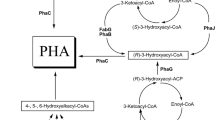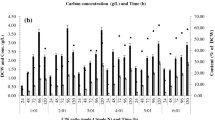Abstract
Microbial bioconversion of a given substrate is considered an efficient and eco-friendly tool for value-added industrial compound generation from natural products. Among natural products, unsaturated fatty acids have been used as substrates to produce various functional hydroxy fatty acids. In this study, we report the production of 7,10-dihydroxy-8(E)-hexadecenoic acid (DHD) from palmitoleic acid by a new strain, Pseudomonas aeruginosa KNU-2B. KNU-2B efficiently produced DHD from palmitoleic acid and required a strong alkaline condition for maximum DHD production. The maximum DHD amount produced under pH 10.0 and 48-h incubation at 27 °C and 150 rpm was 219.5 mg/100 mL culture. Other important nutritional factors were also investigated to obtain optimum DHD production.









Similar content being viewed by others
References
Bae JH, Kim DS, Suh MJ, Oh SR, Lee IJ, Kang SC, Hou ST, Kim HR (2007) Production and identification of a novel compound, 7,10-dihydroxy-8(E)-hexadecenoic acid from palmitoleic acid by Pseudomonas aeruginosa PR3. Appl Microbiol Biotechnol 75:435–440
Bae JH, Suh MJ, Kim BS, Hou CT, Lee IJ, Kim IH, Kim HR (2010) Optimal production of 7,10-dihydroxy-8(E)-hexadecenoic acid from palmitoleic acid by Pseudomonas aeruginosa PR3. New Biotechnol 27:352–357
Bagby MO, Carlson KD (1989) Chemical and biological conversion of soybean oil for industrial products. In: Cambie RC (ed) Fats for the future. Ellis Horwood, Chichester, pp 301–317
Bajpai V, Shin SY, Kim MJ, Kim HR, Kang SC (2004) Anti-fungal activity of bioconverted oil extract of linoleic acid and fractionated dilutions against phytopathogens Rhizoctonia solani and Botrytis cinerea. Agric Chem Biotechnol 47:199–204
Broun P, Somerville C (1997) Accumulation of ricinoleic, lesquerolic, and densipolic acids in seeds of transgenic Arabidopsis plants that express a fatty acyl hydroxylase cDNA from castor bean. Plant Physiol 113:933–942
Chang IA, Bae JH, Suh MJ, Kim IH, Hou CT, Kim HR (2008) Environmental optimization for bioconversion of triolein into 7,10-dihydroxy-8(E)-octadecenoic acid by Pseudomonas aeruginosa PR3. Appl Microbiol Biotechnol 78:581–586
Ellamar JB, Kim IH, Hou CT, Park HS, Kim HR (2019) Isolation and identification of a variant strain of Pseudomonas aeruginosa PR3 with enhanced production of 7,10-dihydroxy-8(E)-octadecenoic acid. Biocatal Agric Biotechnol 18:101068
Hou CT (1994) Conversion of linoleic acid to10-hydroxy-12(Z)-octadecenoic acid by Flavobacterium sp. (NRRL B-14859). J Am Oil Chem Soc 71:975–978
Hou CT (1996) A novel compound, 12,13,17-trihydroxy-9(Z)-octadecenoic acid, from linoleic acid by a new microbial isolate Clavibacter sp. ALA2. J Am Oil Chem Soc 73:1359–1362
Hou CT, Bagby MO (1991) Production of a new compound, 7,10-dihydroxy-8(E)-octadecenoic acid from oleic acid by Pseudomonas sp. PR3. J Ind Microbiol 7:123–130
Hou CT, Bagby MO (1992) 10-hydroxy-8(Z)-octadecenoic acid, an intermediate in the bioconversion of oleic acid to 7,10- dihydroxy-8(E)-octadecenoic acid from oleic acid. J Ind Microbiol 9:103–107
Hou CT, Forman RJ (2000) Growth inhibition of plant pathogenic fungi by hydroxy fatty acids. J Ind Microbiol Biotechnol 24:275–276
Hou CT, Bagby MO, Plattner RD, Koritala S (1991) A novel compound, 7,10-dihydroxy-8(E)-octadecenoic acid from oleic acid by bioconversion. J Am Oil Chem Soc 68:99–101
Kato T, Yamaguchi Y, Abe N, Uyehara T, Nakai T, Yamanaka S, Harada N (1984) Unsaturated hydroxy fatty acids, the self-defensive substances in rice plant against rice blast disease. Chem Lett 25:409–412
Kim H, Gardner HW, Hou CT (2000a) Production of isomeric 9,10,13 (9,12,13)-trihydroxy-11E(10E)-octadecenoic acid from linoleic acid by Pseudomonas aeruginosa PR3. J Ind Microbiol Biotechnol 25:109–115
Kim H, Gardner HW, Hou CT (2000b) 10(S)-Hydroxy-8(E)-octadecenoic acid, an intermediate in the conversion of oleic acid to 7,10-dihydroxy-8(E)-octadecenoic acid. J Am Oil Chem Soc 77:95–99
Kim H, Kuo TM, Hou CT (2000c) Production of 10,12-dihydroxy-8(E)-octadecenoic acid, an intermediate in the conversion of ricinoleic acid to 7,10,12-trihydroxy-8(E)-octadecenoic acid by Pseudomonas aeruginosa PR3. J Ind Microbiol Biotechnol 24:167–172
Kim KR, Oh DK (2013) Production of hydroxy fatty acids by microbial fatty acid-hydroxylation enzymes. Biotechnol Adv 31:1473–1485
Kuo TM, Kim H, Hou CT (2001) Production of a novel compound, 7,10,12-trihydroxy-8(E)-octadecenoic acid from ricinoleic acid by Pseudomonas aeruginosa PR3. Curr Microbiol 43:198–203
Smith S, Witkowski A, Joshi AK (2003) Structural and functional organization of the animal fatty acid synthase. Prog Lipid Res 42:289–317
Suh MJ, Baek KY, Kim BS, Hou CT, Kim HR (2011) Production of 7,10-dihydroxy-8(E)-octadecenoic acid from olive oil by Pseudomonas aeruginosa PR3. Appl Micrbiol Biotechnol 89:1721–1727
Zimmerman DC (1966) A new product of linoleic acid oxidation by a flaxseed enzyme. Biochem Biophys Res Commun 23:398–402
Acknowledgements
This research was supported by the Basic Science Research Program through the National Research Foundation of Korea (NRF) funded by the Ministry of Education (2018R1D1A3B07040443).
Author information
Authors and Affiliations
Corresponding author
Ethics declarations
Conflict of interest
We have no conflict of interest to declare.
Additional information
Publisher's Note
Springer Nature remains neutral with regard to jurisdictional claims in published maps and institutional affiliations.
Rights and permissions
About this article
Cite this article
Moon, JS., Lee, YJ., Kim, IH. et al. Strong alkaline condition is preferable for producing 7,10-dihydroxy-8(E)-hexadecenoic acid from palmitoleic acid by Pseudomonas aeruginosa KNU-2B. Biotechnol Lett 42, 1755–1766 (2020). https://doi.org/10.1007/s10529-020-02899-w
Received:
Accepted:
Published:
Issue Date:
DOI: https://doi.org/10.1007/s10529-020-02899-w




